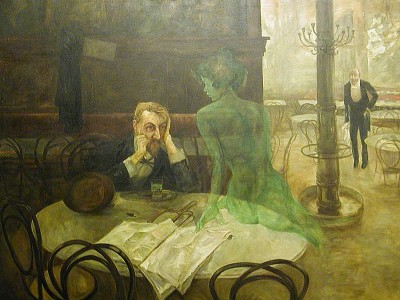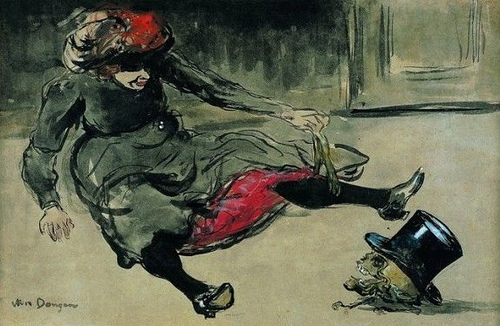In 1930, the legendary bartender Harry Craddock prescribed a popular cure for revellers who stumbled into London’s Savoy Hotel for breakfast and complained of throbbing hangovers. Craddock had fled Prohibition in the States in 1920 and found work at the American Bar in the Savoy, and he knew a thing or two about the ailments of his customers. To ease their pain, he invented a classic cocktail with an unforgettable name—Corpse Reviver #2. Then he published the recipe in a book that bartenders still cherish today: The Savoy Cocktail Book.
This cocktail is a particular favorite of mine—with its pallid greenish hue, its ingenuous blending of slightly tart ingredients, and a name guaranteed to warm the heart of any archaeology writer. But how wise is it to down a drink whose ingredient list includes absinthe, a herbal concoction first blended by a French physician in 1789 as a tonic and later condemned and outlawed by legislators in Europe and the United States as a poisonous social evil? Absinthe, after all, contains oil of wormwood, Artemesia absinthium. Its active ingredient, thujone, is a known natural insecticide.
 Is absinthe really toxic to humans, though? In the years leading up to the First World War, researchers harboured few doubts. In 1912, for example, two French physicians presented a paper at the First International Eugenics Congress held in London, describing horrifying symptoms they had observed in alcoholics who preferred absinthe to other forms of alcohol. “In Absinthism,” they wrote, “the hallucinatory insanity is more active, more terrifying, sometimes provoking most dangerous reactions of extreme violence. It is accompanied by another syndrome of great gravity; all at once the absinthe-drinker shouts out, grows pale, loses consciousness, and falls: the features contract, the jaws are clenched, the pupils dilate, the eyes turn upwards, the limbs stiffen, urine is passed, gas and faeces are smartly expelled.”
Is absinthe really toxic to humans, though? In the years leading up to the First World War, researchers harboured few doubts. In 1912, for example, two French physicians presented a paper at the First International Eugenics Congress held in London, describing horrifying symptoms they had observed in alcoholics who preferred absinthe to other forms of alcohol. “In Absinthism,” they wrote, “the hallucinatory insanity is more active, more terrifying, sometimes provoking most dangerous reactions of extreme violence. It is accompanied by another syndrome of great gravity; all at once the absinthe-drinker shouts out, grows pale, loses consciousness, and falls: the features contract, the jaws are clenched, the pupils dilate, the eyes turn upwards, the limbs stiffen, urine is passed, gas and faeces are smartly expelled.”
If this isn’t enough to turn one off Corpse Revivers forever, nothing is. But one doesn’t hear much about absinthism today, although the drink is still available in many parts of the world, including Canada where I live. So is modern absinthe a different and safer drink than the absinthe of Toulouse-Lautrec and Baudelaire? In 2008, an international research team managed to locate 13 intact and sealed bottles from the pre-World War I era, and analyzed their chemical composition. The results, published in the Journal of Agriculture and Food Chemistry, were surprising. The level of thujone averaged 25.4 milligrams per litre—within the level that the European Union has set for absinthe today, 35 milligrams per litre.
So what lay behind those symptoms described by the two French physicians in 1912? The answer now seems to have little to do with thujone, much less oil of wormwood. In 1999, three researchers who examined the problem published a new theory in the British Medical Journal. In the early 20th century, the trio noted, researchers knew relatively little about alcohol’s neurotoxicity and its damaging effect over the long term on key human organs. It’s a far different story today, they concluded, and “the possibility emerges that much of the syndrome of absinthism was actually acute alcohol intoxication, withdrawl, dependence, and other neuropsychiatric complications – major health and social problems, but not unique to absinthe.”
In other words, a little absinthe won’t harm you and a few Corpse Revivers will not turn you into a violent, convulsive wreck. But Harry Craddock knew all this back in 1930 when he tended bar at the Savoy. He only offered one warning. “Four of these [drinks] taken in swift succession will un-revive the corpse again.”
Corpse Reviver (No. 2) (Courtesy Oh Gosh! )
- 1 shot gin
- 1 shot Cointreau
- 1 shot Lillet Blanc
- 1 shot fresh lemon juice
- Dash of absinthe or substitute
- Shake well with ice and strain in to a cocktail glass. Garnish with a maraschino cherry.
Upper Image: Kees van Dongen – Absinthe Drinker on a street (1902), courtesy Cea. Bottom Image: Viktor Oliva: The Absinthe Drinker, courtesy Wikimeda Commons. The original painting can be found in the Café Slavia in Prague.

I just want a sip of yours, Heather, if you wouldn’t mind. The recipe scares me.
Ann, I think you’d love it, really. Be brave. I’ve never done the hare of the dog thing, but for after five, highly, highly recommended.
I wonder if something other than the alcohol that accompanied the absinthe might be responsible for the peculiar madness in the drinkers. Perhaps some heavy metal contamination in the production or in the wormwood?
It’s that maraschino cherry tips it over the edge for me! Happy Christmas to LWON.
Shane: An Austrian team has taken a look at the possibility of heavy metal contamination in wormwood. Their results are here:
http://www.springerlink.com/content/qkuld573rwtyn220/fulltext.pdf
The team found that Artemesia absinthium did concentrate cadmium–a heavy metal–and that some plants in Austria possessed .42 milligrams of cadmium per kilogram. But this was less than buckwheat or linseed, and did not reach a critical level.
Lovers of absinthe might also remember this scene in Eurotrip:
http://www.youtube.com/watch?v=qdvRElQMhCc
Thanks, Geoff.
Thanks for the link Heather! Might need to follow this one up with my Instrumental Methods class.
If you never had ABSINTHE, it tastes like licorice and turns a milky white/ green when you mix it with water. To do it right you need a contraption that pours the water over a cube of sugar into the ABSINTHE. You can make quite the ordeal of it. It is like what the French call a pastiche which are perfect on a hot afternoon. The buzz doesn’t seem to be that hypnotic, just like regular hooch. It is pricy, I guess, because it is still novel, about $60 for a fifth. If you like Sambucca , or anise you should try it, just don’t drink it straight.
Well who knows, maybe the lemon and the maraschino cherry will neutralize the effects of the absinthe? I’m kidding of course!
I think it is now generally accepted that ‘absinthism’ was caused by consuming adulterated spirits. Unscrupulous 19th century hooch manufacturers simply coloured their alcohol green with copper salts and added salts of antimony (highly toxic) to create the absinthe louche or cloudiness with water. It is also likely that the alcohol used may have been contaminated with methanol which is deadly.
Modern absinthe is made to high quality standards and is no more(or less) harmful than any other spirit. Enjoy and drink in moderation!
http://www.absintheonline.com/myth_reality_absinthe.pdf
Ian: Really interesting point, but I haven’t found any evidence for copper salts and antimony in 19th century absinthe in the scientific papers I read. Do you have a link or two to these papers? In the paper I cited above from the Journal of Agriculture and Food Chemistry, the team did indeed test for copper and antimony in the preban bottles of absinthe in their sample. The level of copper in all but one of the 13 bottles was inconspicuous; none revealed any detectable levels of antimony.